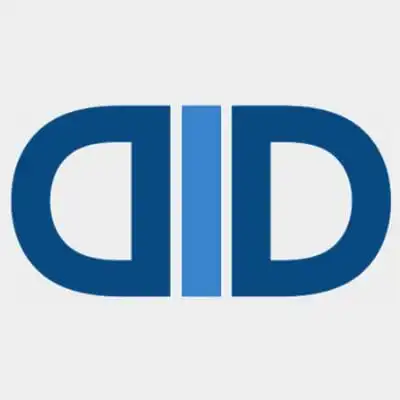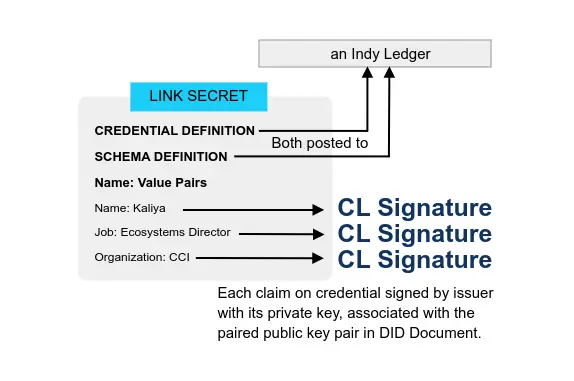Linked Data and the Semantic Web
Getting Started
- Whatever Happened to the Semantic Web? From: TwoBitHistory Type: Post Date: 2018-05-27
- LinkedData - W3C Wiki From: W3C Type: Entry Date: 2016-08-01
- Linked Data - Design Issues From: W3C By: Tim Berners Lee Type: Page Date: 2006-07-27
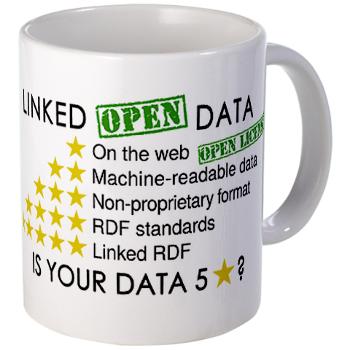
- Awesome Semantic Web From: Semantalytics Type: List Date: 2023-04-26
- Awesome Linked Data From: Nandana Mihindukulasooriya Type: List Date: 2017-03-07
- An overview of the Linked Open Data datasets. From: Datahub Type: List Date: 2018-05-10

- Publishing and consuming Linked Data embedded in HTML From: W3C Type: Page Date: 2011-06-26
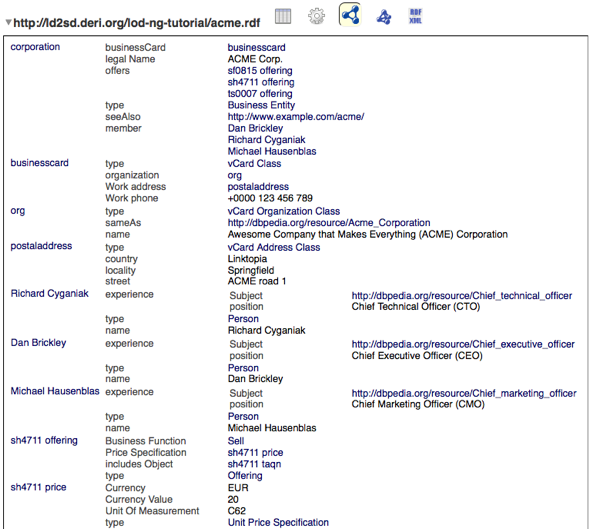
- Linked Data for Enterprises By: Kerstin Forsberg Type: Page Date: 2016-12-15

- Examples in the Wild << Pretty Awesome List From: Read-Write Linked Data Type: Wiki Date: 2019-07-03
- Understanding Linked Data slide deck (in Remark.js format) From: Solid Type: Presentation Date: 2019-10-03
- Introducing Linked Data And The Semantic Web From: LinkedDataTools Type: Page Date: 2011-06-12

In 2001, Tim Berners-Lee, inventor of the World Wide Web, published an article in Scientific American. Berners-Lee, along with two other researchers, Ora Lassila and James Hendler, wanted to give the world a preview of the revolutionary new changes they saw coming to the web. Since its introduction only a decade before, the web had fast become the world’s best means for sharing documents with other people. Now, the authors promised, the web would evolve to encompass not just documents but every kind of data one could imagine
The idea behind these principles is on the one hand side, to use standards for the representation and the access to data on the Web. On the other hand, the principles propagate to set hyperlinks between data from different sources. These hyperlinks connect all Linked Data into a single global data graph, similar as the hyperlinks on the classic Web connect all HTML documents into a single global information space. Thus, LinkedData is to spreadsheets and databases what the Web of hypertext documents is to word processor files. The Linked Open Data cloud diagramms give an overview of the linked data sets that are available on the Web.
The Semantic Web isn’t just about putting data on the web. It is about making links, so that a person or machine can explore the web of data. With linked data, when you have some of it, you can find other, related, data.
Like the web of hypertext, the web of data is constructed with documents on the web. However, unlike the web of hypertext, where links are relationships anchors in hypertext documents written in HTML, for data they links between arbitrary things described by RDF,. The URIs identify any kind of object or concept. But for HTML or RDF, the same expectations apply to make the web grow:
- Use URIs as names for things
- Use HTTP URIs so that people can look up those names.
- When someone looks up a URI, provide useful information, using the standards (RDF*, SPARQL)
- Include links to other URIs. so that they can discover more things.
A curated list of various semantic web and linked data resources.
A list of tools for publishing and consuming Linked Data.
A group for Linked Open Data datasets. The initial import of data for this group was done in October 2009 from the list of RDF datasets dumps provided by the W3C Linked Open Data Interest Group.
This document provides guidelines for how to create and consume Linked Data embedded in HTML. It extends and updates [HOWTO-LODP] and the [COOL-SWURIS] Note. The examples in this document use RDFa 1.1 and microdata with a special focus on Schema.org vocabulary terms.
Keeping myself up to date on the practical use of Linked Data in Enterprises and related topics
dokieli is a decentralised article authoring, annotation, and social notification tool which works from Web browsers. It is built with the following principles in mind: freedom of expression, decentralisation, interoperability, and accessibility.
A slide deck introduction to Linked Data aimed at developers.
What is Linked Data and the Semantic Web and what is all the hype about? Principally, the Semantic Web is a Web 3.0 web technology - a way of linking data between systems or entities that allows for rich, self-describing interrelations of data available across the globe on the web.
Main
- Designing a Linked Data developer experience By: Ruben Verborgh Type: Post Date: 2018-12-28
- Linked Data Capabilities From: WebofTrustInfo By: Christopher Lemmer Webber, Mark S. Miller Type: Paper Date: 2022-12-28 Event: rwot05-boston
- Identity as Linked Data on Immutable Ledgers From: WebofTrustInfo Type: Paper Date: 2016-10-17 Event: rwot3-sf
- Blockchain Extensions for Linked Data Signatures From: WebofTrustInfo By: Manu Sporny, Harlan Wood, Noah Thorp, Wayne Vaughn, Christopher Allen, Jason Bukowski, and Dave Longley Type: Paper Date: 2016-10-30 Event: rwot3-sf
- Resource Integrity Proofs From: WebofTrustInfo By: Ganesh Annan, Kim Hamilton Duffy Type: Paper Date: 2018-12-12 Event: rwot7-toronto
- Recent happenings with Linked Data Capabilities From: WebofTrustInfo Type: Paper Date: 2018-03-02 Event: rwot6-santabarbera
- LD Signature Format Alignment From: WebofTrustInfo Type: Paper Date: 2017-08-18 Event: rwot4-paris
- Authorization Capabilities for Linked Data v0.3 From: CCG Type: Specification Date: 2023-01-22
Making decentralized Web app development fun
While the Semantic Web community was fighting its own internal battles, we failed to gain traction with the people who build apps that are actually used: front-end developers. Ironically, Semantic Web enthusiasts have failed to…
Linked Data Signatures enable a method of asserting the integrity of linked data documents that are passed throughout the web. The object capability model is a powerful system for ensuring the security of computing systems. In this paper, we explore layering an object capability model on top of Linked Data Signatures via chains of signed proclamations. fn:1 We call this system “Linked Data Capabilities”, or “ld-ocap” for short.
Content creators on the Web are getting a raw deal. They get a fraction of a cent for an ad played on YouTube, and nothing on Facebook, for filling these sites with traffic-driving content. It’s hard to make a living when you’re a creative. Licensing is hard; the user experience is bad, so lawyers and middlemen extract the most value. In the music industry, more money flows into the pockets of distributors than creatives. Consumers are often happy to pay for their content. Instead, they’re forced to sit through ads.
The term Linked Data is used to describe a recommended best practice for exposing, sharing, and connecting information on the Web using standards, such as URLs, to identify things and their properties. When information is presented as Linked Data, other related information can be easily discovered and new information can be easily linked to it. Linked Data is extensible in a decentralized way, greatly reducing barriers to large scale integration.
With the increase in usage of Linked Data for a variety of applications, there is a need to be able to verify the authenticity and integrity of Linked Data documents. The Linked Data Signatures specification added authentication and integrity protection to linked data documents through the use of public/private key cryptography without sacrificing Linked Data features such as extensibility and composability.
Cryptographic linking provides discoverability, integrity, and scheme agility
Contributors: Manu Sporny, Dave Longley, David Lehn, and Bohdan Andriyiv
Currently, the Web provides a simple yet powerful mechanism for the dissemination of information via links. Unfortunately, there is no generalized mechanism that enables verifying that a fetched resource has been delivered without unexpected manipulation. Would it be possible to create an extensible and multipurpose cryptographic link that provides discoverability, integrity, and scheme agility?
Cryptographic linking solutions today have yet to provide a generalized mechanism for creating tamper-evident links. The Subresource Integrity standard limits this guarantee to script and link resources loaded on Web pages via the use of HTML attributes. IPFS provides a verification mechanism that is constrained to hash-based, content-addressable links, with no ability to complete content negotiation. RFC6920 proposes another mechanism that cannot be applied to existing links: it recommends the use of named information hashes and a resolution method that creates a content addressable URL [1]. Resource Integrity Proofs incorporates ideas from these standards and solutions to provide a new data format for cryptographic links that is fit for the open world.
Veres One’s architecture has been adjusted to take full advantage of Linked Data Capabilities as its primary mechanism for granting authority to perform operations on the ledger as well as on DID Documents. permission to update key materials can be conditionally handed out to an entity (or entities) and later revoked if deemed appropriate using Linked Data Capabilities’ design.
As for ledger updates, Accelerators also make use of Linked Data Capabilities. To prevent spamming the ledger, the costs of an update must somehow be accounted for. The traditional way to do this on a blockchain is to use proof of work, and this is also an option in Veres One, but for those use cases where expending time and energy on proof of work is less desirable users can use an “accelerator”.
An accelerator is an entity that has been granted a capability to perform updates on the ledger more quickly. Accelerators may likewise take advantage of Linked Data Capabilities’ support for delegation, with or without caveats.
The goal of the “LD Signature Format Alignment” Working Group at Rebooting the Web of Trust IV was to investigate the feasibility and impact of the proposed 2017 RSA Signature Suite spec, which brings JSON-LD signatures into alignment with the JOSE JSON Web Signature (JWS) standards.The 2017 RSA Signature Suite is based on RFC 7797, the JSON Web Signature (JWS) Unencoded Payload Option specifcation. This approach avoids past concerns about JWT raised in the LD signature adopters, including:•Increased space consumption associated withbase-64 encoding.•Difculty of nesting or chaining signatures, leading to data duplication.•Use of a format that is not a JSON object, preventing ability to rely exclusively on a JSON document-based storage engine (whilepreserving the signature)
Authorization Capabilities for Linked Data (ZCAP-LD for short) provides a secure way for linked data systems to grant and express authority utilizing the object capability model. Capabilities are represented as linked data objects which are signed with Linked Data Proofs. ZCAP-LD supports delegating authority to other entities on the network by chaining together capability documents. “Caveats” may be attached to capability documents which may be used to restrict the scope of their use, for example to restrict the actions which may be used or providing a mechanism by which the capability may be later revoked.
[…] Relationship to Verifiable Credentials […]
We seem to be in a conundrum. Claims and credentials are forms of correlation that allow us to reason about an entity in our squishy human world, but are unsafe when used as mechanisms to authorize some event to occur within a system. Capabilities are a safe mechanism to model the flow of authority through a system, but there are times when capabilities have not been granted and we need to make a “judgement call” by correlating information about that entity. What should we do?
To pose the question is to see the answer: the right approach is to use each system for what it does best. Use correlation (Verifiable Credentials) in a reasoning system (most commonly human reasoning) as a path to make judgements about whether to hand an entity a specific set of initial capabilities. Use capabilities (ZCAP-LD) as the mechanism to grant and exercise authority through computing systems. To return to our system administrator example, when Alice applies for the job, she submits a series of credentials about her prior work history and degree, and Eva is able to verify that it is Alice’s former employers and university which have made these claims. Deciding that Alice is fit for the job, Eva hands Alice her initial capability which grants her authority to administrate the systems in question (with a caveat that allows Eva to revoke that authority at a future date, if appropriate). Alice uses that capability as the initial entry point into administrating the system.
Implementation
- Java implementation of Linked Data Signatures From: WebofTrustInfo Type: Code Date: 2023-05-13
- Linked Data Keys Registry From: CCG Type: Registry Date: 2020-12-29
- Linked Data Capabilities reference implementation From: DigitalBazaar Type: Code Date: 2023-01-14
This is an implementation of the following cryptographic suites for Linked Data Proofs:
Ed25519Signature2018
Ed25519Signature2020
EcdsaSecp256k1Signature2019
RsaSignature2018
JsonWebSignature2020
JcsEd25519Signature2020
JcsEcdsaSecp256k1Signature2019
This repository contains the Linked Data Cryptographic Suite Registry which is a list of all known Linked Data cryptographic suites and their current level of maturity.
JavaScript reference implementation for Authorization Capabilities.
RDF
- RDF AND JSON-LD UseCases From: W3C Type: Page Date: 2014-09-15
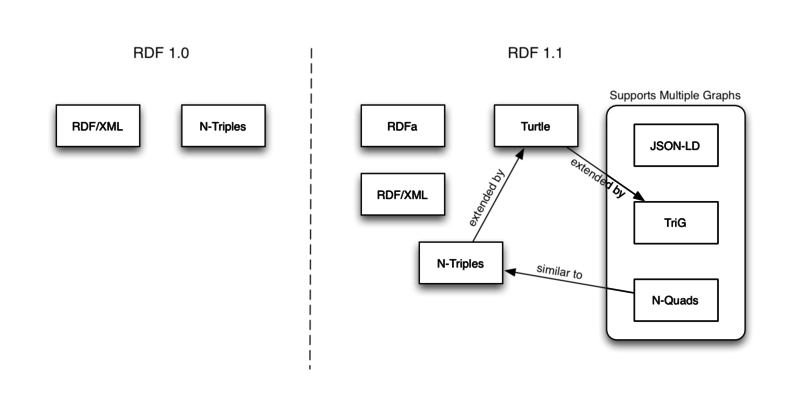
- Comparison of RDFJS libraries From: W3C Type: Entry Date: 2019-01-18
- RDF.js: The new RDF and Linked Data JavaScript library From: W3C Type: Post Date: 2018-04-23
- RDF Dataset Canonicalization From: RCH Working Group Type: Report Date: 2023-05-24
This wiki page strive to address one of many question about use of RDF vs JSON-LD to store linked data. This page attempts to provide a general introduction of both the technologies and provide suitability analysis of various kind of applications to use either technology.
This is a comparison of JavaScript libraries for working with RDF.
A diverse web requires decentralized data storage and maintenance. According to MIT’s Tim Berners-Lee, “it is about making links, so that a person or machine can explore the web of data. With Linked Data, when you have some of it, you can find other, related, data”.
Zazuko’s CTO Thomas Bergwinkl adds that “Linked Data is built on top of the web stack and the programming language of the web is JavaScript. It is crucial for Web Developers to have access to well-designed JavaScript libraries to work with RDF and Linked Data”.
The RDFJS W3C Community Group did a tremendous job in defining a standard to represent Linked Data in JavaScript. Several individuals and groups started to implement the RDFJS specification.
RDF [RDF-CONCEPTS] describes a graph-based data model for making claims about the world and provides the foundation for reasoning upon that graph of information. At times, it becomes necessary to compare the differences between sets of graphs, digitally sign them, or generate short identifiers for graphs via hashing algorithms. This document outlines an algorithm for normalizing RDF datasets such that these operations can be performed.

